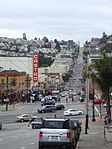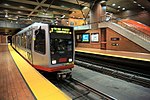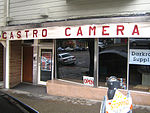Castro Theatre

The Castro Theatre is a historic movie palace in San Francisco that became San Francisco Historic Landmark #100 in September 1976. Located at 429 Castro Street in the Castro District, it was built in 1922 with a California Churrigueresque façade that pays homage—in its great arched central window surmounted by a scrolling pediment framing a niche—to the basilica of Mission Dolores nearby. Its designer, Timothy L. Pflueger, also designed Oakland's Paramount Theater and other movie theaters in California during that period. The theater has over 1,400 seats (approx 800 downstairs and 600 in the balcony). The theater's ceiling is the last known leatherette ceiling in the United States and possibly the world. Another leatherette ceiling was demolished just a few years ago. To make the ceiling look as though it is leather requires a special technique regarded as lost today.
Excerpt from the Wikipedia article Castro Theatre (License: CC BY-SA 3.0, Authors, Images).Castro Theatre
Castro Street, San Francisco
Geographical coordinates (GPS) Address Phone number Website External links Nearby Places Show on map
Geographical coordinates (GPS)
| Latitude | Longitude |
|---|---|
| N 37.762 ° | E -122.435 ° |
Address
Castro Theatre
Castro Street 429
94114 San Francisco
California, United States
Open on Google Maps







